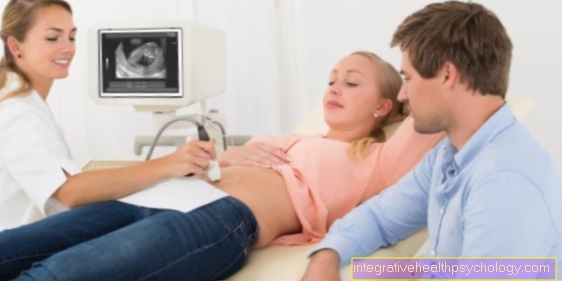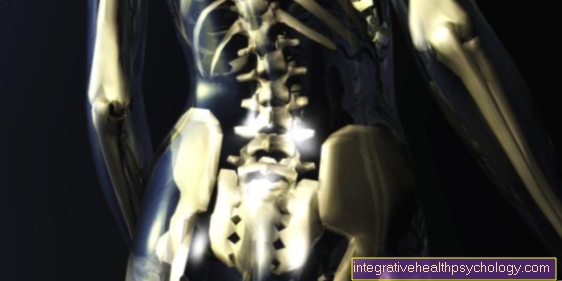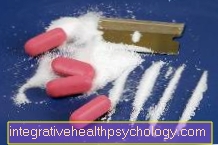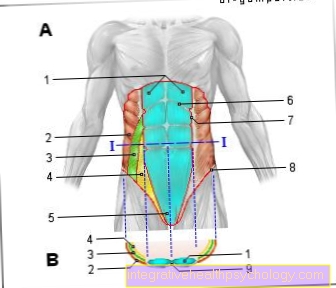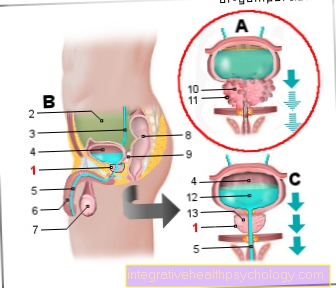Increased heart rate during menopause
introduction
Menopause refers to the years from the decline in the woman's fertile period to the complete cessation of ovarian function. During this time, physical complaints often occur, which are of varying severity and may subside by themselves after a while.
An increased heart rate can also be traced back to the hormonal changes at the beginning of the menopause. Often the cardiovascular system regulates itself again after a while and the circulatory problems and the increased pulse decrease.
Other symptoms caused by menopause, such as a decrease in bone density due to the lack of estrogen, however, do not subside by themselves and often require specific therapy.
Read more about this: Menopause

causes
The ovaries produce numerous hormones which, in addition to sexual function, also affect other processes in the body. The most important hormones of the ovaries are progesterone and estrogen.
With the onset of menopause, the hormone levels of these two hormones drop sharply, resulting in numerous complaints that are summarized as "climacteric complaints".
A typical malfunction with the onset of menopause is overactivity of the so-called "sympathetic nervous system". This leads to increased blood pressures in the cardiovascular system and an increased pulse. Other complaints such as hot flashes, dizziness and headaches can also be attributed to the activation of the sympathetic nervous system during menopause.
Also read: Menopause hormones
diagnosis
In most cases, the diagnosis of so-called “climacteric complaints” can already be made on the basis of an anamnesis and physical examination. Typically, the increased heart rate occurs during menopause in combination with other symptoms such as hot flashes, headaches and sweats.
The increased pulse can be recorded by means of a simple pulse measurement. An ECG examination over 24 hours can be carried out for further diagnosis. With this, cardiac arrhythmias and other structural disorders of the heart function can be roughly excluded. An increase in blood pressure during menopause is also possible.
This can also be examined more closely with the help of long-term blood pressure measurement. The need for treatment can also be estimated on the basis of the long-term measurement. If there is a significant increase in the pulse or blood pressure, possibly combined with other cardiac arrhythmias, drug therapy may be required.
Concomitant symptoms
The increase in heart rate is due to an increase in the so-called "sympathetic" nervous system. This nervous system controls some body processes that are also activated and thus cause symptoms. These reactions are collectively referred to as the body's "escape reaction".
High blood pressure, a tendency to sweat, blushing, increases in blood sugar, tension in the muscles, dilation of the pupils and decreased salivation are typical side effects that can occur during menopause.
This can also result in fatigue, headaches, insomnia, problems urinating, and numerous other symptoms. Other vegetative and hormonal complaints such as water retention, reduced bone density and mood swings can occur in other ways during the menopause. However, these have a different mechanism of origin.
You might be interested in: Signs of menopause
treatment
Treatment can be done in different ways and depends on the extent of the discomfort.
Mild complaints often do not require any drug therapy. Physical exercise, stress reduction and adequate rest can already bring about good results with mild symptoms. Furthermore, naturopathic remedies such as soy, green tea or tofu can be used to treat menopausal symptoms.
In some cases, advanced symptoms require medication with so-called "anticholinergics" or hormone preparations to compensate for the dropping hormone levels during the menopause. Hormone preparations such as estrogen that are active locally or throughout the body can be used. Their use must be weighed under strict criteria, as they can be associated with further complaints and increased cancer risks.
Learn more: Medication for menopause
Duration
An increased heart rate during menopause and other so-called "climacteric" symptoms usually occur before the onset of menopause, when hormone levels drop and there are greater fluctuations in the hormone balance. This period can last for several years and can be balanced with medication if necessary.
Overall, it takes 10 years to go through menopause and menopause completely. After this period, the symptoms can subside. Hormonal complaints can rarely persist after the menopause has subsided, so that hormone replacement therapy is also necessary in the long term.
Also read the article: The menopause.
Course of disease
A rule of thumb is that menopause begins about 5-6 years before menopause and lasts 5-6 years until after menopause occurs.
During this period, the body gets used to the hormonal changes. The symptoms are also strongest during this time. If there are no severe symptoms resulting from the hormone deficiency, the symptoms subside after this interval, which means that the body has become completely used to the new hormone balance.
About halfway through menopause, menopause sets in, which is characterized by the lack of ovulation and menstrual bleeding.








